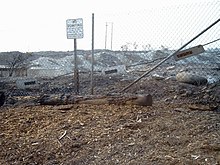
San Bernardino County, officially the County of San Bernardino and sometimes abbreviated as S.B. County, is a county located in the southern portion of the U.S. state of California, and is located within the Inland Empire area. As of the 2020 U.S. Census, the population was 2,181,654, making it the fifth-most populous county in California and the 14th-most populous in the United States. The county seat is San Bernardino.

Rancho Cucamonga is a city located just south of the foothills of the San Gabriel Mountains and Angeles National Forest in San Bernardino County, California, United States. About 37 mi (60 km) east of Downtown Los Angeles, Rancho Cucamonga is the 28th most populous city in California. The city's seal, which centers on a cluster of grapes, alludes to the city's agricultural history including wine-making. The city's proximity to major transportation hubs, airports, and highways has attracted the business of several large corporations, including Coca-Cola, Frito-Lay, Big Lots, Mercury Insurance Group, Southern California Edison, and Amphastar Pharmaceuticals.

The Pomona Valley is located in the Greater Los Angeles Area between the San Gabriel Valley and San Bernardino Valley in Southern California. The valley is approximately 30 miles (48 km) east of downtown Los Angeles.

Rancho Cucamonga was a 13,045-acre Mexican land grant in present-day San Bernardino County, California, given in 1839 to the dedicated soldier, smuggler and politician Tiburcio Tapia by Mexican governor Juan Bautista Alvarado. The grant formed parts of present-day California cities Rancho Cucamonga and Upland. It extended easterly from San Antonio Creek to what is now Hermosa Avenue, and from today's Eighth Street to the mountains.

The Cucamonga Valley is a region of southwestern San Bernardino County and northwestern Riverside County, in southern California. It is located below the San Gabriel Mountains in the Inland Empire region.

Sam Maloof was an American furniture designer and woodworker. Maloof's work is in the collections of several major American museums, including the Metropolitan Museum of Art, the Los Angeles County Museum of Art, the Philadelphia Museum of Art, and the Smithsonian American Art Museum. Maloof, the first craftsman to receive a MacArthur fellowship, was described by The New York Times as "a central figure in the postwar American crafts movement".

The San Bernardino Valley is a valley in Southern California located at the south base of the Transverse Ranges. It is bordered on the north by the eastern San Gabriel Mountains and the San Bernardino Mountains; on the east by the San Jacinto Mountains; on the south by the Temescal Mountains and Santa Ana Mountains; and on the west by the Pomona Valley. Elevation varies from 590 feet (180 m) on valley floors near Chino to 1,380 feet (420 m) near San Bernardino and Redlands. The valley floor is home to over 80% of the more than 4 million people in the Inland Empire region.

Chaffey Joint Union High School District is a 9–12 school district located in San Bernardino County, California, United States that serves the communities of Ontario, Montclair, Rancho Cucamonga, and portions of Fontana, Upland, Chino, and Mount Baldy. With more than 25,000 students, it is one of the largest high school districts in the state. The district operates eight comprehensive high schools, one online high school, one continuation high school, one community day school, and one adult education school.

California's 35th congressional district is a U.S. congressional district in California. The district is currently represented by Democrat Norma Torres.
Etiwanda is the easternmost of three formerly unincorporated communities that became part of Rancho Cucamonga, California, in 1977.
Etiwanda School District is a school district located in San Bernardino County, California that serves the community of Etiwanda, which is part of the incorporated city of Rancho Cucamonga, a portion of Fontana, and the remainder of the district is in San Bernardino County territory.

The Cucamonga Valley AVA is an American Viticultural Area in San Bernardino County, California. It is in the Cucamonga Valley region of the Pomona Valley, about 15 miles (24 km) west of San Bernardino.
Central School District is a K-8 school district in San Bernardino County, California that covers a portion of Rancho Cucamonga. The district currently serves approximately 5,200 students. The district feeds into Chaffey Joint Union High School District.
Alta Loma School District is a K-8 school district in San Bernardino County, California that covers Rancho Cucamonga. It was established in 1885 and currently serves approximately 6,800 students. The district feeds into Chaffey Joint Union High School District.
Summit Intermediate is a public school in Rancho Cucamonga, California. It is one of the sixteen schools of the Etiwanda School District.
Summit Heights is a planned community in north Fontana, California.
The Baseline League is a high school athletic conference that is part of the CIF Southern Section. Members are located in San Bernardino County, with Damien and St. Lucy's located in Los Angeles County. The Baseline League was formed in 1979, with original members Claremont High School, Glendora High School, Pomona High School, Chaffey High School, Damien High School, St. Lucy's Priory High School, Pomona Catholic Girl's High School, and Upland High School.

Tapia Adobe was the home of Tiburcio Tapia (1789–1845). Tiburcio Tapia was a Mexican soldier, politician, then became a merchant, winery owner and ranch owner, in what is now Cucamonga, California. The place of Tapia Adobe (home) was designated a California Historic Landmark (No.360) on October 9, 1939. Tiburcio Tapía received the land to build his Adobe and Rancho Cucamonga from a 1839 13,045-acre (52.79 km2) Mexican land grant in present-day San Bernardino County, California The land grant was from Mexican governor Juan Bautista Alvarado. The grant formed parts of present-day Rancho Cucamonga and Upland. It extended easterly from San Antonio Creek to what is now Hermosa Avenue, and from today's Eighth Street to the mountains.

The Etiwanda Depot is a former railway station of the Pacific Electric Railway, located in Rancho Cucamonga, California. The station was principally in service for the Upland–San Bernardino Line.

















